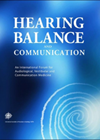
Journal Reviews
Auditory processing in children with unilateral hearing loss
It is a common assumption that unilateral hearing loss (UHL) in children is of little consequence because appropriate development of speech and language can still occur with one normal hearing ear. Recent studies, however, suggest that there are significant differences...






